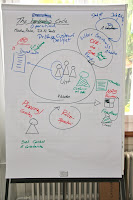Announcing Radical Management Training
17-12-2011Ideas on How to Start Global Management Warming in #stoos
24-12-2011“Scrum has been so successful because it is a simple framework that is easy to teach and easy to follow. A framework for general management needs this same simplicity.”
This morning, fellow Scrum coach and evangelist Mischa Ramseyer and I were brainstorming on how to accelerate the transformation of management for the #Stoos Gathering. Mischa’s words echoed my own long held beliefs. We have seen Scrum succeed over and over, mostly in software development contexts. What are the deeper patterns that can be applied to all management situations and how can we distill them into an easy-to-teach, easy-to-apply framework?
What would be the characteristics of this framework?
- It would be simple. The rituals can be followed easily.
- It would be based on the same values and principles as Agile, Scrum and Kanban. In particular trust, transparency and respect.
- It would focus on achieving customer delight.
- It would ensure a clear line of sight from those doing the work to those customers or users benefiting from the work.
- It would incorporate checks and balances, so that when the organization comes under pressure, the system can correct itself.
- It would define cadences to ensure that all important activities are performed regularly.
- It would ensure the impediments are visible and handled effectively.
- It would be modifiable, scalable and enhanceable to fit a wide variety of situations.
We came up with two repeating cycles, an operational cycle and a strategic cycle. Each cycle represents a time frame; shorter time frames repeat within the cycle. During the cycle various rituals take place, e.g. planing or a functional review. The operational cycle covers the monthly-daily time frames while the strategic cycle extends from quarterly to weekly time frames.
In each cycle, the customer is portrayed in the middle, together with the teams doing the work, regardless of whether the customer is physically present, because producing positive outcomes for the customer is of key importance.
The operational cycle
The operational cycle is about getting work done and creating outcomes which customers will value. It consists of three set of rituals, monthly, weekly and daily. Each is represented as a circle. A team and their customers are at the center of this cycle.
- Monthly – for planning and measuring outcomes and results (customer delight/NPS, functional review and operational retrospective)
- Weekly – for ensuring the culture and relationships are alive and well
- Daily – rituals for organization and encouraging teamwork, such as daily stand-ups, updating the information radiators.
Information radiators (such as Kanban or Scrum boards, Impediment lists, Happiness Index) should broadcast key information, e.g. pending work, work in progress, or staff and customer satisfaction.
The organization should measure and evaluate customer delight at regular intervals. We believe integrating this in to the monthly cycle both for operational and strategic cycles will often be appropriate, but this may be context specific.
We did not really define roles, but someone must be responsible for making impediments visible and escalating them should they not get resolved. To ensure no conflicts of interest and an effective flow of information, that person should not normally be the same person who brings work to the team or who represents more powerful institutions in the organization.
We also believe that a team-based approach is more effective than mere collections of individuals. Teams work together to achieve common goals, share information with each other, and compensate each other’s weaknesses, so the whole is stronger than the sum of the individuals. This is especially true in leadership roles.
The strategic cycle
The strategic cycle is about making the company an effective place to get work done and to innovate for the customer.
The strategic cycle also consists of three sets of rituals, represented on circles over a somewhat longer timescale. Together with the management team, the company’s customers are again at the center of this cycle.
- Quarterly: Each quarter the company should improve: “from version 1.0 to v1.1.” Planning & Review are focused on making the company more effective, more sustainable, better loved and generally better.
- Monthly: Ensure optimal conditions for doing work and continuous improvement. Measure and react to essential feedback (e.g. NPS, Happiness Index, Financials, unsolved impediments)
- Weekly – like in the operational cycle, ensuring the culture and relationships with the company are alive and well
The monthly cycle is where the strategic and operational cycles overlap. The information radiators, especially the stuck-impediments list, ensure that essential information is available for all who need to see it.
How do these cycles scale? The cycle diagram itself is intended as an information radiator. What does your company need to do to be successful? The planning and review meetings, artifacts and tools that we defined should provide the basis for an effective Plan-Do-Check-Act culture, but they may not be sufficient for a particular situation. So you can move rituals from one circle to another or add additional rituals as appropriate. You can also create longer or shorter time scales and define the relationships between them.
Looking for Resonance
What is your reaction to this approach? What resonates with you? What makes you think ‘this will never work!’ Beyond #stoos, I will be teaching a Radical Management course with Steve Denning and would like to integrate a simple approach to doing Radical Management into the course. What would you add? What would you take away?



